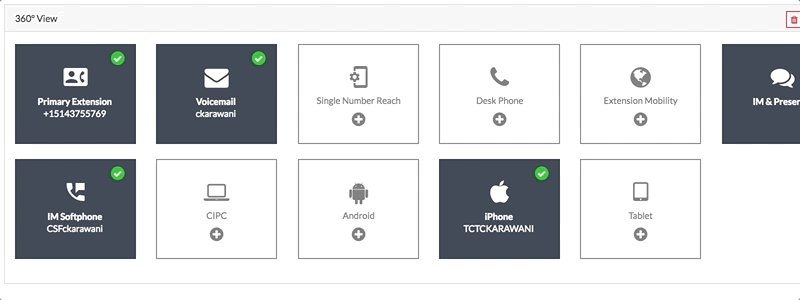Cisco has recently publicly released the latest version of their Collaboration Systems Release (CSR), 12.0. Although not the most innovative release of Cisco’s on-premise Unified Communications (UC) solution (with most R&D efforts going into the cloud-based Cisco Spark platform nowadays), there are still notable new features and changes worth mentioning.
The objective of this blog post is to bring focus to some features which the Stack8 team considers relevant, and not to provide an exhaustive list of new features and bug fixes. As always, official Cisco release notes should be consulted when planning for upgrades of your UC applications.
Common Enhancements
A few common initiatives between the different products will see the light of day with CSR 12.0, namely:
- Support for the new Apple Push Notification Service (APNS): In a future iOS release, Apple will be making changes will prevent Cisco Jabber for iPhone and iPad from running in the background for an extended period and will terminate the application if not running in the foreground after some time. This would effectively prevent Jabber from providing notifications of a new call or new IM events, as an example. With CSR 12.0 products (CUCM, CUC, IM&P, Expressway, and Jabber), as well as the latest 11.5(1) SR releases, changes have been made to support APNS, which will re-enable Jabber to receive notifications of new events, even when not running in the foreground. Read our blog for more information on this topic
- Support for TLS 1.2 and for disabling previous TLS versions: All organizations who are PCI-DSS compliant need to pay attention to this. Read our blog for more information on this topic
- Support for VMware ESXi 6.5.
- OAuth 2.0 support for Jabber authentication: More secure, less frequent user logins on mobile devices and faster login time.
- Smart Licensing: see below for a complete description of what this is.
Smart Licensing
A Cisco-wide effort to reduce complexities around acquiring, installing and managing licenses for Cisco’s software-based solutions, Smart Licensing is now making its way into the Collaboration portfolio of products. Gone are the days of registering PAK numbers on Cisco’s Licensing Portal, generate license file requests, installing license files on Cisco Unified Communications Manager (CUCM), Cisco Unity Connection (CUC) and the likes.
The concept behind Smart Licensing is simple: Cisco holds all licenses for your software-based products, and all products connect back to Cisco to validate their entitlement and license consumption. This methodology easily allows for licenses pooling across an organization, centralizes the management of the different licenses you own and consume, as well as decouples licenses with the product instances that consume them.
Standing up a new system with Smart Licensing, CUCM for example, is now simplified in the following manner:
- Purchases of Cisco software licenses get electronically and directly transferred to a Smart Account on Cisco’s Smart Software Manager portal.
- After standing up the new application (a new CUCM virtual machine, in our example), you add your Smart Account token (again found on Cisco’s portal) to your product instance. This will allow it to register back to Cisco using the right Smart Account.
That’s it, happy days! For organizations where UC servers are not granted direct Internet access, an optional proxy server, named Cisco Smart Software Manager Satellite, can be downloaded free of charge and deployed to act as a secure intermediate between Cisco and your products located inside your private network.
CSR 12.0 brings Smart Licensing to CUCM, CUC as well as Cisco Emergency Responder (CER) and CUCM Session Management Edition (SME). Other products within Cisco’s Collaboration portfolio should follow suit as well in the following releases.
Cisco Unified Communications Manager (CUCM) 12.0
Enhancements for integration with the Cisco Collaboration Cloud for Spark
- New operating system: CentOS
- Optimizations for faster upgrades
- Extension Mobility: ability to login using a numeric Directory Number, instead of an alphanumeric User ID
- For heavy Extension Mobility users, this feature will be a relief! Some organizations had even opted to sync their Active Directory End-User accounts using the “telephone” or “ipPhone” field instead of “sAMAccountName,” in order to workaround this limitation, creating lots of further headaches when turning on more advanced functionalities such as Jabber – this will no longer be required.
- Feature parity for IPv6-only endpoints, compared to IPv4-only endpoints
- Support for Cisco Meeting Server (CMS) as ad-hoc video bridge in CUCM.
- Deprecated phones: 7921, 7970 and 7971 phone models will no longer register to CUCM 12.0 and will need to be replaced by 8800 Series IP phones.
With Stack8’s Moves, Add and Changes System: SMACS, swapping a user’s phone can be done in less than 10 seconds! 
Cisco Unified Communications Manager Instant Messaging & Presence (IM&P) 12.0
- Centralized IM&P Cluster:
- For larger organizations with multiple CUCM clusters, a single centralized IM&P cluster can now be created for providing IM & presence functionalities for end-users attached to multiple CUCM clusters.
- This allows the easy creation of a “private cloud service” for IM&P services, and greatly reduces the solution footprint.
- Native clean-up utilities:
- External database clean-up, for removing stale information for Jabber services stored on external PostgreSQL servers: persistent chats, managed file transfers, and message archives.
- Stale Roster clean-up, for removing stale contacts for IM&P contact lists.
- Support for Microsoft SQL Server as an external database for Persistent Chat in High Availability.
- Calendar Integration support for Microsoft Office 365, which will allow users to show as “In a meeting” based on their O365 Exchange calendar status.
Cisco Unity Connection (CUC) 12.0
- Opus Codec Support (careful: port capacity is reduced by 50% when using this codec, due to the heavy computation required for encoding/decoding).
- IPv6-only Endpoints Support.
- For field engineers: CUC 12.0 will now be installed using its own dedicated ISO, contrary to previous versions where it shared the same ISO as CUCM.
Cisco Expressway X8.11
- MRA Enhancements: Call Recording Support, Hunt Groups Support, Scale Improvements.
- IM&P Federation with external Microsoft Skype for Business environments.
Cisco Jabber 11.9
- Jabber for Windows, iOS and Android: shared line support over MRA.
- Jabber for Mac: integrations to Outlook (presence, click-to-chat and click-to-call).
- All platforms: updated set of emoticons, also now including animated emoticons.
- All platforms: Jabber & Spark interoperability. If you have Spark interop enabled, you can send and receive 1:1 messages from your contacts on Spark. The presence status of interop enabled contacts will be displayed as “On Cisco Spark” within Cisco Jabber.
- This feature is currently limited to WebEx Messenger users (e., Jabber Cloud).
Cisco Unified Contact Center Express (UCCX) 11.6
- CUIC User Experience Refresh
- New Finesse features:
- New widgets: Recent Call and Recent State. These two popular functionalities were available with Cisco Agent Desktop (CAD) and Cisco Supervisor Desktop (CSD) but had never made it to Finesse until now.
- Direct Transfer: until now, only Consult Transfer was available with Finesse.
- Make Call from Ready state: until now, an agent always needed to go to Not Ready state before initiating a call from Finesse.
- Silent Monitoring of Outbound Calls: until now, only inbound calls could be monitored by supervisors.
- Single-sign On (SSO) for agents and supervisors.
- Web Chat:
- Group Chat support.
- Scheduling: you can now define business hours for Web Chat, which will drive the behavior of the chat module on the website UCCX is integrated with (e., send a message that “The contact center is currently closed.” when outside of business hours).
- E-mail & Web Chat: support for wrap-up codes, with support for categories for an easier
- Enhanced Outbound Campaign management: the ability to automatically import contacts to outbound campaigns via SFTP.
Should you require any help with your next Cisco Unified Communications infrastructure upgrade the Stack8 team of experts is here to help you.
Ready to take your unified communications from headache to hassle-free?
No throwing darts at proposals or contracts. No battling through the back-end. No nonsense, no run-around.



